#なばなの里
Explore tagged Tumblr posts
Text
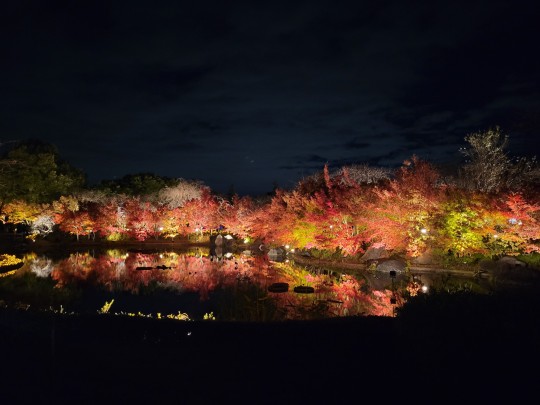



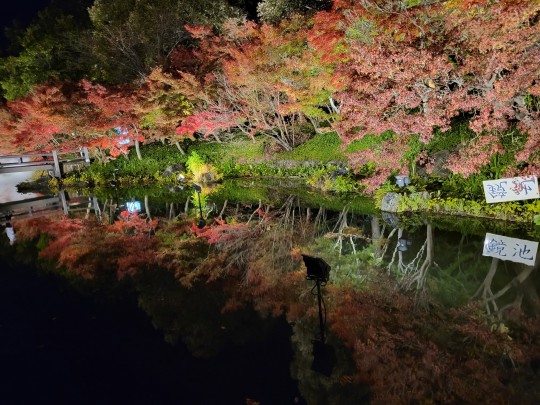
なんとも綺麗な光でした
2023.12.02
2 notes
·
View notes
Text
2年前のナガシマリゾート
どうも😄2年前に行った、ナガシマリゾートの画像をご覧下さい。
2022/08/07撮影




0 notes
Text
日本燈飾排名第1的 名花之里 (なばなの里)
日本燈飾排名第1的 名花之里 (なばなの里)
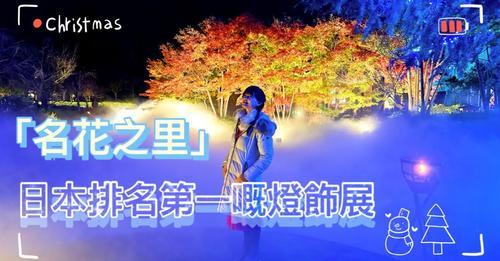

「唔想睇字可以睇片, 拉到最底有我拍既 YOUTUBE 片介紹, 詳細好多的 ^^ 」
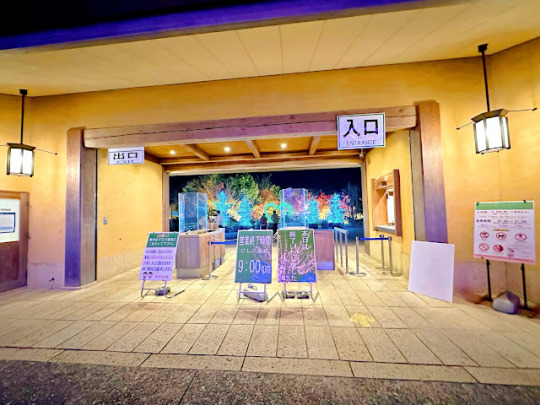

今次旅程住名古屋,除咗浸天然溫泉之外,就係嚟呢個日本排名第一嘅燈飾展「名花之里」
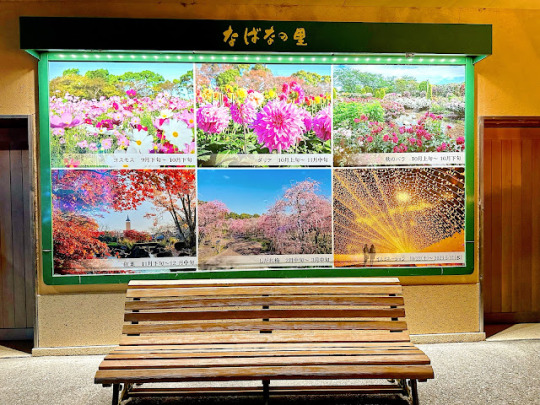
「名花之里」喺日本國內最大型嘅夜間燈飾展。 場內有好多不同嘅燈海打卡位,真係好靚呀!



一入場就見到高度45公尺可緩緩昇起的眺望台,不過要另外付錢啊!
「名花之里」一共有6個主要打卡位
最吸引人一定係全長200公尺嘅���之隧道「光之隧道」。





我哋12月初嚟嘅,都幾多人,如果想影冇人嘅打卡相,真係有啲難度。
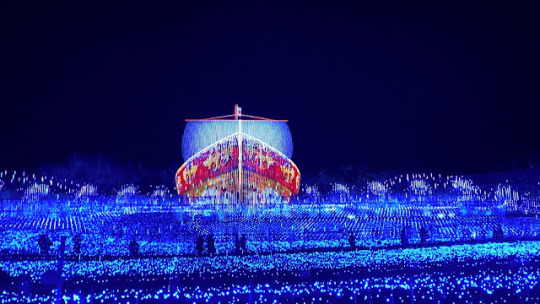
地方實在太大,呢度行吓嗰度影吓時間就好快過。
行行吓就見到個大型LED燈光Show「天空之船」。
睇完大概7分鐘嘅表演再繼續行,就會去到「光之隧道 - 櫻」,
呢條隧道同之前嗰條唔同,係會變色㗎!
一時係充滿少女心嘅粉紅色燈泡組成,有時又會變成全綠色!這個隧道拍片比較好睇!
其實仲有以藍色及白色LED燈泡為主的光之雲海,用燈泡設計的拱門特別有歐陸Feel,
當日見到好多人排緊影相,我哋就無等啦!
仲有個長達120米的光之大河,喺日本最大規模的水上LED燈光裝置!
不過當日我哋唔夠時間行晒,因為我哋仲要趕去食飯!
大家記得用埋門票送俾你嘅現金券,食埋飯先走啊!
門票2500円一位,當中有1000円係可以喺場內使用!我哋就去咗呢間餐廳食飯!
「名花之里」附近仲有長島三井Outlet、長島溫泉(湯あみの島)及長島溫泉樂園,
啱晒一家大細嚟玩!
1. 光之隧道
2. 光之聖誕樹
3. LED燈光Show「天空之船」
4. 光之隧道 - 櫻
5. 光之雲海
6. 水上燈光 – 光之大河

日本燈飾排名第1的 名花之里 (なばなの里) https://youtu.be/SHB-PlHHI0s

名花之里 2022 – 2023 夜間燈飾資訊
日期:2022年10月22日至2023年5月31日
票價:2500円一位。(大小同價)
營業時間: 平日 10:00~21:00、星期五六至22:00
「名花之里」官方網站 https://www.nagashima-onsen.co.jp/nab...
なばなの里「名花之里」 〒511-1144三重県桑名市長島町駒江漆畑270
TEL:0594-41-0787
#名花之里 #名古屋 #osaka #travevlog #vlog #vlogger #travelblogger #大阪 #日本景點 #日本旅行 #日本旅遊 #lovecath #夏沫 #環遊世界 #なばなの里 #長島 #天然溫泉 #溫泉
謝謝大家來看LoveCath夏沫的文章啊~^^~Catherine (LoveCath夏沫),電郵 [email protected] / [email protected]
Instagram ~ http://instagram.com/lovecathcath
Fans Page ~ http://www.facebook.com/lovecathcath Facebook ~ http://www.facebook.com/cath.lovecath YouTube ~ http://www.youtube.com/c/LoveCath夏沫 Openrice ~ http://www.openrice.com/restaurant/userinfo.htm?userid=758718 分享平台 Blog Girlssss ~ https://girlssss.com/author/lovecath/
Blogspot ~ http://lovecath.blogspot.com/ She ~ http://blog.she.com/lovecath/ ESDLife ~ http://wow.esdlife.com/lovecath UBlog ~ http://blog.ulifestyle.com.hk/blogger/lovecath/ bastillepost ~ https://www.bastillepost.com/hongkong/author/2814-lovecath?variant=zh-tw Wordpress ~ https://lovecathcath.wordpress.com/ Weshare ~ http://www.weshare.hk/lovecath Pixnet ~ http://lovecath.pixnet.net Fanpiece ~ http://women.fanpiece.com/lovecath/ Tumblr ~ http://www.lovecathcatherine.tumblr.com
Seewide ~ https://www.seewide.com/space-1126.html
Rebeaute ~ https://rebeaute.hk/author/lovecath/
Medium ~ https://medium.com/@lovecathcath
Girlab ~ https://girlab.hk/all-blog-posts/frontend-publishing/status/publish/
Beautylife ~ http://beautylife.hk/home.php?mod=space&uid=76979
Qooza ~ http://beauty.qooza.hk/u/LoveCathCath/shares
LoveCath 夏沫


3 notes
·
View notes
Photo

(Xユーザーの朱里/shuriさん: 「こちらのイラストのえっち差分とあほえろ展開なおまけもろもろの記事を公開しました🥳☘️ 大人のお友達のみ閲覧が可能ですよろしければ🙏 https://t.co/eTgS6LkD6I https://t.co/PwbdJxnubR」 / Xから)
175 notes
·
View notes
Text






傳谷 英里香は、日本の女優。千葉県出身。KON-RUSH所属。女性アイドルグループ「ベイビーレイズJAPAN」のリーダーであった。 ウィキペディア
生まれ: 1995年11月2日 (年齢 29歳), 千葉県
映画: なれたら
身長: 158 cm
事務所: レプロエンタテインメント(-2022年7月); KON-RUSH(2022年11月-)
血液型: B
日本人の父とフィリピン人の母との間に生まれた。洗礼名はアンジェラ(Angela:イタリア語で天使の意味)。日本語の語順ではアンジェラ傳谷英里香となる。
スポーツ全般が得意。公式プロフィール記載の特技であるバスケットボールは小中の7年間部活に入部しており、中学生時代には副キャプテンを務めていた。同じ時期、水泳部、陸上部も掛け持ちしていた。スキューバダイビングは2017年夏に日帰りで資格を取得。
運動能力反射神経ともにメンバーの中ではずば抜けており、ベイビーレイズのメンバーと運動で争う企画では独壇場であった。
ピアノも幼少時より習っており、「第17回Japan Expo」のため渡仏した折には撮影で訪れたモンマルトルの丘にて両親の思い出の曲であるサザン��ールスターズの「TSUNAMI」を演奏し、居合わせた現地の人や観光客の注目を集めた。
ベイビーレイズJAPAN結成以前はモデルまたはソロアーティスト志望であり、黒木メイサや安室奈美恵を目標としていた。このため結成当初はアイドル活動に全く乗り気では無く、自身のTwitterやブログなどで「元々アイドルというものが苦手でやりたくなかった。」とも語っていた。しかし、ベイビーレイズJAPANのメンバーとして活動していくにつれて「今は(アイドルが)好きです。ちゃんと言えます。」「前の自分に会ったら引っぱたきたいくらい全然違う世界だった。」と思うようになり、アイドルに対する考え方も変わっていったという。
ベイビーレイズ時代は「やるならとことん」を座右の銘としてことあるごとに明言しており、キャッチフレーズにもなり実際の行動規範ともしていた。
10代の間に体験しておきたいと、20歳の誕生日前に群馬県のみなかみバンジーでバンジージャンプを体験した。
ベイビーレイズ(JAPAN)時代はハーフと言うこともあり漢字が苦手キャラであったが、読書家であり実際はそれほど苦手ではない。自身の苗字の「傳」の字もバランスよく書きこなし、客観的には達筆の部類に入る。
『世界ふしぎ発見!』(TBS)の解答者として初めて出演した回を含め合計3度{2019年5月時点}もの全問正解のパーフェクト賞を獲得し、推理力・考察力に秀でた才女ぶりも披露している。
ロック音楽が好き。2017年1月に名古屋で共演してからSUPER BEAVERの大ファンとなり、1人でワンマンライブに参戦するほどである。女性シンガーでは阿部真央やあいみょんが好き で、ファンクラブイベントで彼女らの曲を歌唱披露したこともある。
読書好きであり、仕事の合間を縫って様々な本を読んでいる。哲学書や自己啓発本も好んで読む。小説も幅広く読むが、川村元気や住野よるの作品に造詣が深い。漫画はほとんど読まないが、ファッション関係の仕事に関心が強いこともあり、『ランウェイで笑って』は好きな作品であると表明している。
映画も非常に好きで、オフや仕事の空き時間を縫ってよく鑑賞する。幅広いジャンルを鑑賞するが、ドキュメンタリー���が好み。ファンイベントでは、おススメの映画として『グッド・ウィル・ハンティング/旅立ち』、『湯を沸かすほどの熱い愛』、『ワンダー 君は太陽』、『ルーム』、『君が生きた証』を挙げ、作品に対する熱い想いを大いに語った。
195 notes
·
View notes
Text
Quirk counseling: canon, the cultural references and what we can guess from this all (now with the bit about Chap. 431)
So, a recent ask I received pushed me to dig more into Quirk counseling, in hope I could offer better information about it.
Also thanks to @poppy5991 who helped me to expand the overmentioned ask adding to it things I forgot to mention. Hopefully this time I've covered things better. If not, I apologize.
2024-12-05 edit: As Horikoshi added a bit about Quirk counseling in Chap. 431 I've expanded this post to include that too. You can find it at the bottom of the post under the title "CHAPTER 431 AND WHAT IT TELLS TO US".
LOOKING AT CANON AND WHAT IT TELLS US
There’s not much about Quirk counseling as it gets mentioned, as far as I know, exactly 6 times in the whole 42 volumes (and the anime).
The first time Quirk counseling comes up, is after Shigaraki’s attack in chap. 22... and not much is said.
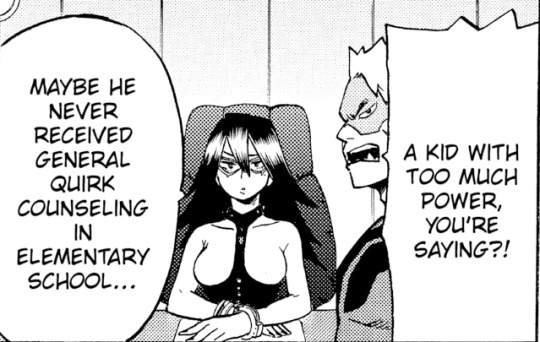
MIDNIGHT ‘Shōgaku-ji no “issei ‘kosei’ COUNSELING” uke tenai no kajira...’ ミッドナイト「小学時の『一斉〝個性〟カウンセリング 』受けてないのかじら...」 Midnight “Didn’t he receive “universal/mass/simultaneous ‘Quirk’ counseling” in elementary school?” [Chap. 22- Ep. 14]
From what Midnight says we can infer that ‘Issei “kosei” COUNSELING’ [一斉〝個性〟カウンセリング “universal/simultaneous/mass ‘Quirk’ counseling”] is given in elementary school as kind of a group activity or class lesson as ‘issei’ (一斉) generally is used to say “simultaneous”, “all at once”, which should imply all the kids at elementary school (or more likely, all the kids in a class) get it at the same time.
For contest, Midnight brings this up because they think Tomura has too much power and was never taught to ‘control’ it (as in not to use it to do what he wants). So we can guess Quirk counseling would, in their mind, have given Tomura a better grasp of what was allowed to do with his Quirk and what wasn’t (with becoming a Villain being definitely on the ‘Don’t do it’ list).
The discussion about Quirk counseling won’t progress any further.
The next time Quirk counseling is mentioned is in chap. 165.
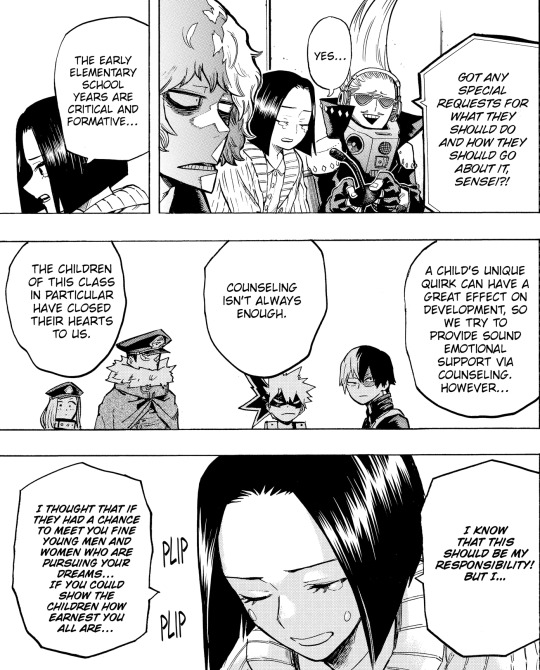
Ikoma Komari ‘Hai… shōgakkō teigakunen wa jinkaku keisei ni oite taisetsuna jiki desu...〝Kosei〟 no chigai ga ōkiku eikyō suru tame COUNSELING o okonai. Sukoyakana seishin o hagukumeru yō SUPPORT suru no desu ga... COUNSELING mo bannōde wa arimasen. Kono CLASS no ko-tachi wa watashi-tachi ni kokoro o tozashite shimaimashita. Watashi no sekinindearu koto wa shōchi shite imasu...! Desuga...! Yume ni mukatte hagende rassharu minasama to fureau koto de massuguna kimochi o omoidasa sete age rarereba…’ 生駒小麿里「はい…小学校低学年は人格形成に於いて大切な時期です...〝個性〟の違いが大きく影響する為カウンセリングを行い。健やかな精神を育めるようサポートするのですが...カウンセリングも万能ではありません。このクラスの子たちは私達に心を閉ざしてしまいました。私の責任であることは承知しています...!ですが...!夢に向かって励んでらっしゃる皆さまと触れ合うことでまっすぐな気持ちを思い出させてあげられれば…」 Ikoma Komari “Yes... the early years of elementary school are an important time for personality development... differences in “Quirk” have a big impact, so we provide counseling. We support them in developing a healthy mind... but counseling is not a panacea. The children in this class have closed their hearts off to us. I know that it is my fault...! But...! I hope that by interacting with all of you who are working hard towards your dreams, we can help them remember their honest feelings...” [Chap. 165-Ep. 79]
Here we don’t talk specifically of Quirk counseling, just of counseling and of how ‘differences in Quirk’ have a big impact on personality development, also adding that counseling is not a fix-it-all. Ironically though, all the kids in the class seems to be the same according to their teachers, ‘mondaiji’ (問題児 “problem children”) who’re always ‘hanko-teki’ (反抗的 “rebellious”/“defiant”) no matter what she does despite them all having very different Quirks, children who have ‘closed their heart’ to them (aka they aren’t listening to them anymore) and feel they’re better than anyone else and it’s clear with this class counseling didn’t work at all.
We jump at chap. 226.
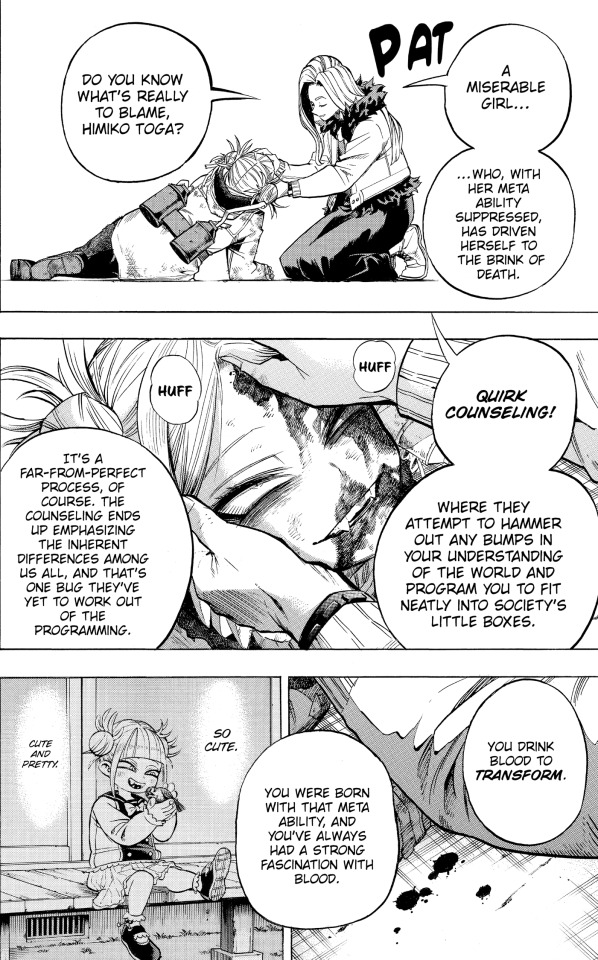
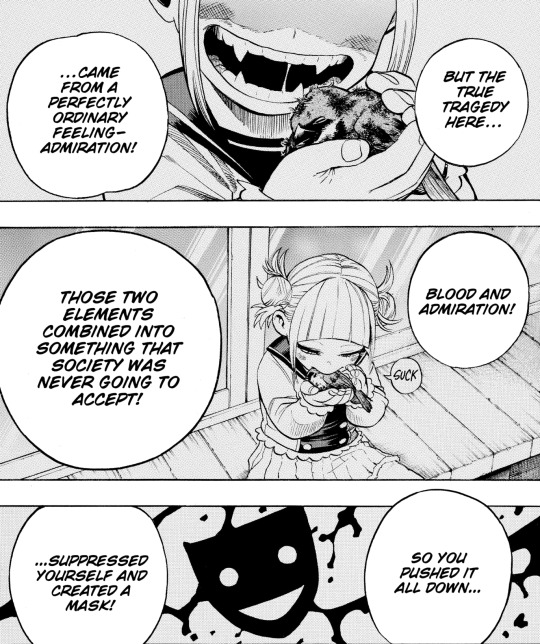
CURIOUS ‘Inō no yokuatsu ni yotte jibun o koroshita fukōna shōjo, sore ga anata nandesho? Toga Himiko. ‘“Kosei” COUNSELING’, jita rikai no yugami o kyōseishi shakaisei no suri awase o hodokosu jōsō kyōiku (read: PROGRAM). Mochiron, kanpekina PROGRAM de wa naishi, kojinsa o yori tsuyoku kanjite shimau to iu mondai o kakaete imasu. Chi o nomi henshin suru, umaretsuki motsu sono inō ni yotte anata wa “chi” ni tsuyoi kyōmi o hikareru yō ni natta. Shikashi shin no fukō wa “akogare” to iu dareshimo ga daku futsū no kanjō. Chi to akogare kamiatte shimatta nitsu no yōso wa tōtei shakai ni ukeire rareru MONO de wa nakatta. Dakara, anata wa FUTA o shita. Jishin o yokuatsu shi kamen o tsukutta.’ キュリオス「異能の抑圧によって自分を殺した不幸な少女、それがあなた���んでしょ?渡我被身子(トガヒミコ)。『〝個性〟カウンセリング』、自他理解の歪みを矯正し社会性の擦り合わせを施す情操教育(プログラム)。もちろん、完璧なプログラムでは無いし、個人差をより強く感じてしまうという問題を抱えています。血を飲み変身する、生まれつき持つその異能によってあなたは〝血〟に強い興味を引かれるようになった。しかし真の不幸は〝憧れ〟という誰しもが抱く普通の感情。血と憧れ噛み合ってしまった2つの要素は到底社会に受け入れられるモノではなかった。だから、あなたはフタをした。自信を抑圧し仮面を作った。」 Curious “You’re an unfortunate girl who killed herself by suppressing her supernatural powers, aren’t you? Toga Himiko. ‘“Quirk” counseling’, it’s an emotional education (read: program) to correct distortions in self-understanding and other things, and to adjust for socialization. Of course, it’s not a perfect program, and it has the problem of making individual differences even more apparent. Your innate ability to transform by drinking blood has made you very interested in “blood”. However, your true misfortune is “admiration”, a normal emotion that anyone can have. The two elements that go together, blood and admiration, were never going to be accepted by society. So you put a lid on it. You suppressed your confidence and made a mask.” [Chap. 226]
Episode 109 should be the one in charge to transpose this scene in animation but episode 109 cut the references to Quirk counseling.
CURIOUS ‘Inō no yokuatsu ni yotte jibun o koroshita fukōna shōjo. Sore ga anata nandesho? Toga Himiko. Umaretsuki motsu sono inō ni yotte anata wa chi ni tsuyoi kyōmi o hikareru yō ni natta. Shikashi, shin no fukō wa akogare to iu dareshimo ga daku futsū no kanjō to chi e no kyōmi, kono futatsu ga kamiatte shimatta koto. Sore wa tōtei shakai ni ukeire rareru MONO de wa nakatta. Dakara, anata wa FUTA o shita. Jishin o yokuatsu shi kamen o tsukutta.’キュリオス「異能の抑圧によって自分を殺した不幸な少女。それがあなたなんでしょ?渡我被身子。生まれつき持つその異能によってあなたは血に強い興味を引かれるようになった。しかし、真の不幸は憧れという誰しもが抱く普通の感情と血への興味、この二つが噛み合ってしまったこと。それは到底社会に受け入れられるモノではなかった。だから、あなたはフタをした。自信を抑圧し仮面を作った。」 Curious “You're the unfortunate girl who killed yourself by suppressing your supernatural powers. That's you, isn't it? Toga Himiko. The supernatural power you were born with has made you very interested in blood. However, your true misfortune was that your fascination with blood and your normal emotion of longing were intertwined. This is something that could never be accepted by society. So you put a lid on it. You suppressed your confidence and made a mask.” [Ep 109]
It’s a bad decision as Quirk counseling was meant to become important later but that’s what they decided to do.
Anyway in the manga there’s something we can work with, if before we were told Quirk counseling helps in developing personality, here it’s clarified the help is aimed at helping people to act ‘normal’, so that they can have a correct perception of themselves as well as socialize and interact correctly, the problem is it suppresses whatever is judged ‘not normal’ in a person and Quirks often generate wild differences between what’s normal for a person and what’s normal for another.
The result of this is that Quirk counseling ends up remarking in an even stronger way the differences between people, by forcing them to suppress feelings that are dictated by their Quirk.
We then jump to chap. 370.
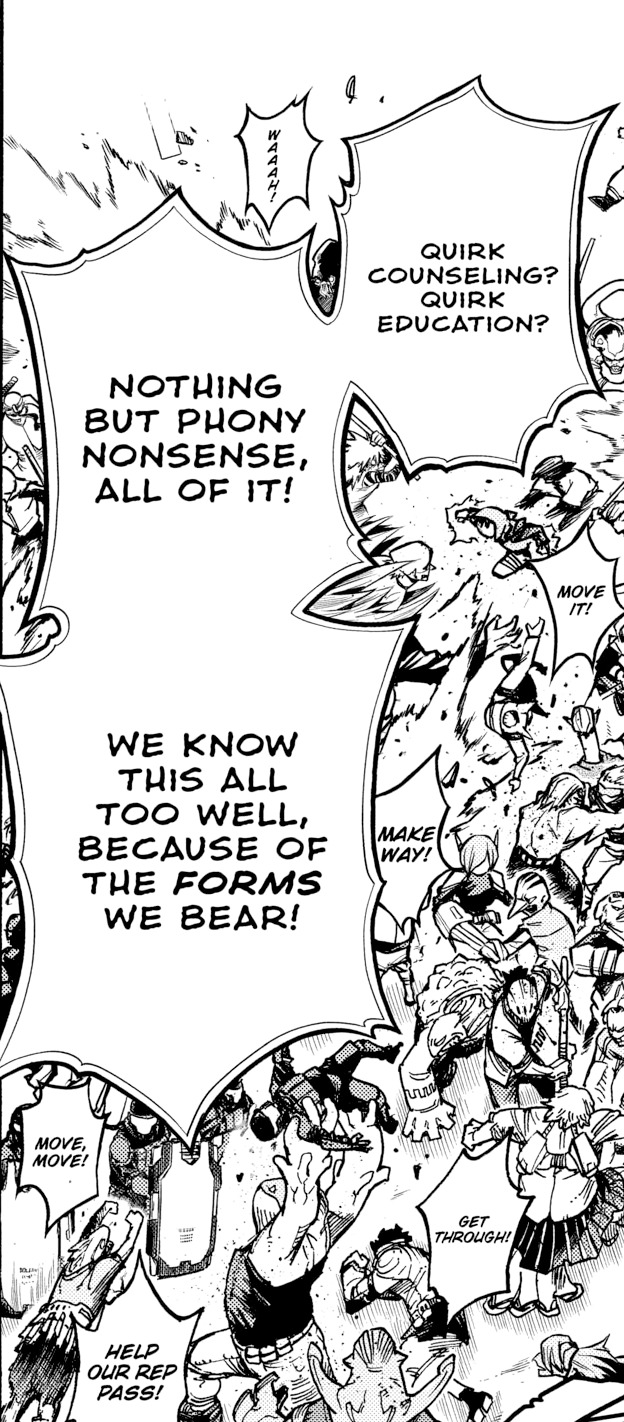
? ‘“Kosei” COUNSELING!” Kosei” kyōiku! Kore ga nise (read: mayakashi) de aru koto o! Wareware wa “katachi” o motte shitte iru!.’ ?「〝個性〟カウンセリング!〝個性〟教育!これが贋(まやかし)である事を!我々は〝形〟を持って知っている!」 ? ““Quirk” counseling! “Quirk” education! This is phony/bogus/sham (read: fake/deception)! We know it due to having this “shape/form”!” [Chap. 370-Ep. 152]
At this point we’ve a nameless heteromorph guy claiming Quirk counseling (along with Quirk education) is basically a sham, it’s not it didn’t work with that class of kids by coincidence, it’s just something that doesn’t really work with Heteromorphs.
While there’s not really an explanation we can guess that, if the point of Quirk counseling is making people ‘normal’, Heteromorphs, who in Japanese are called ‘Igyō’ (異形 “abnormal”), have a hard time with it, since they’re not normal by definition and can’t really change/suppress their ‘not normal’/‘heteromorphic’ traits.
We aren’t told what Heteromorphs are told during Quirk counseling, and the thing is made more complex by how somehow in big cities there’s no discrimination, while in rural villages people still go for ‘chiharai’ (血祓い “blood cleansing”), beating and scarring Heteromorphs who dare to come into contact with not-Heteromorphs, no matter if it’s to save them.
We then jump to chap. 392.
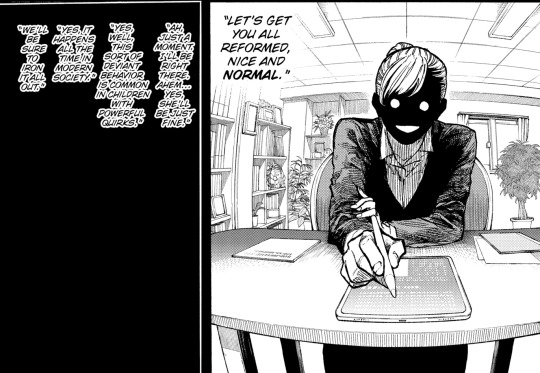
? ‘HAI kyōsei shite ikimashou “futsū” ni. A HAI mō chotto matte kudasai. Sugu sotchi ikimasu. Etto… ē daijōbudesu. Sō desu ne… tsuyoi “kosei” o motsu ko niarigachi na tōsaku desu yo. Kono shakai de wa yoku aru koto desu. Tadashite keshite ikimashou.’ ?「ハイ矯正していきましょう〝普通〟に。あハイもうちょっと待ってください。すぐそっち行きます。えっと…ええ大丈夫です。そうですね…強い〝個性〟を持つ子にありがちな倒錯ですよ。この社会ではよくあることです。正して消していきましょう。」 ? “Yes, let’s correct it and make it “normal”. Ah, yes, please wait a moment. I’ll be there right away. Um... yes, it’s okay. Well... it’s a common perversion among children with strong “Quirks”. It’s common in this society. Let’s correct it and eliminate it.” [Chap. 392]
Here we see a person talking with Himiko’s parents. We aren’t told this person is a Quirk counselor but, I guess, that’s the idea. It’s hard to say if she’s Himiko’s teacher or an external figure, however it makes clear Quirk counseling is more or less what Curious said. That person thought Himiko being fascinated by blood was wrong, she actually calls it a ‘tōsaku’ (倒錯 “perversion”), albeit one she labels as common, and tried to force Himiko to suppress her feelings so she could perceive herself and socialize with the others in a ‘correct’ way.
An interesting difference between the manga and the anime is that in the anime that person’s talk is more streamlined... and we see her also talking with Himiko's parents.


? ‘Hai kyōsei shite ikimashou futsū ni. Sō desu ne… tsuyoi kosei o motsu ko niari-gachina tōsakudesu yo. Kono shakaide wa yoku aru kotodesu. Sei shite keshite ikimashou.’ ?「ハイ矯正していきましょう普通に。そうですね…強い個性を持つ子にありがちな倒錯ですよ。この社会ではよくあることです。正して消していきましょう。」 ? “Yes, let's correct it and make it normal. It's a perversion that is common among children with strong Quirks. It's a common occurrence in this society. Let's correct it and eliminate it.” [Ep. 158]
This might imply that in the manga that person is actually busy with more things at once, she doesn’t have a lot of time to dedicate to Himiko’s parents and therefore she doesn’t have a lot of time to dedicate to Himiko.
Back to the conversation though, regardless of the source, the person talking makes clear that what Himiko does isn’t just something that’s “rude”/“inappropriate” to do in society but that it’s a “perversion”, a common one, yes, but a “perversion” and she says so to her parents who were already worried she wasn’t human.

Chichioya ‘Mō nekko ga!’ 父親「もう根っこが!」 Father “Her core/roots is/are already– (gone/rotten)!”
Hahaoya ‘Ningen ja nai ko un jatta!’ 母親「人間じゃない子産んじゃった!」 Mother “I gave birth to a child that isn’t human!” [Chap. 392-Ep. 158]
And later
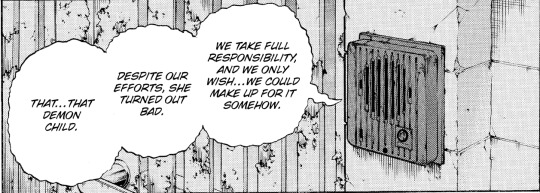
Hahaoya ‘Watashi-tachi ga waruin desu. Mō… tsugunai kirenai desu… ganbatta kedo damedattan desu… ano ko ha… akuma no konan desu.’ 母親「私たちが悪いんです。もう…償い切れないです…頑張ったけど駄���だったんです…あの子は…悪魔の子なんです。」 Mother “It's our fault. We can never make up for it. We tried our best but it was no use. That child is a demon's child.” [Chap. 226]
So Quirk counseling didn’t really reassure her parents nor solved Himiko’s problems. They weren’t going to accept that Himiko could have different feelings from the norm and help her to cope with them correctly, they just wanted to eradicate them from her. As she couldn’t, she was forced to suppress them… and since she couldn’t keep them bottled up forever they eventually exploded and lead her to hurt Saito.
The last time Quirk counseling comes up is at the end of the manga.

? ‘Tsudzuite wa TEAM-UP NEWS. INGENIUM, FROPPY, CREATI soshite URAVITY ga zenkoku no shōgakkō o megutte imasu. Teki (read: VILLAIN) hasseiritsu no genshō ni tomonai katsudō no haba wo hirogeru “HERO”-tachi sono naka demo-- URAVITY no uchidashita “kosei” COUNSELING kakuchō keikaku wa ima mottomo hitsuyō fukaketsuna katsudō to iwa rete imasu.’ ?「続いてはチームアップニュース。インゲニウムフロッピー・クリエティそしてウラビティが全国の小学校を巡っています。敵(ヴィラン)発生率の減少に伴い活動の幅を広げる〝ヒーロー〟たちその中でもーーウラビティの打ち出した〝個性〟カウンセリング拡張計画は今最も必要不可欠な活動と言われています。」 ? “Next up is team-up news. Ingenium, Froppy, Creativity and Uravity are touring elementary schools across the country. As enemy (read: Villain) occurrence rates decrease, the ���heroes” are expanding the scope of their activities. Among them, Uravity’s “Quirk” counseling expansion plan is said to be the most essential activity right now.” [Chap. 430]
In this bit it seems that expanding Quirk counseling became a key factor in lowering the occurrence rate of Villains… which, of course, doesn’t seem to be possible since in almost all the other cases in which Quirk counseling was mentioned it turned out it either didn’t work (with the Masegaki elementary school kids) or made matters worse (Himiko and the heteromorphs). Is it a typing mistake as apparently the program already reached all the elementary schools so it didn’t need to be expanded and, anyway, didn’t work? Or does ‘expanding’ refers to actually put more resources and people in Quirk counseling so they can actually devote more time to the kids and help them better? Hard to say.
LOOKING AT THE CULTURAL CONTEST AND WHAT IT TELLS US
Counseling in Japan
While, of course, there’s no Quirk counseling in Japan, by 2006 Japan had school counselors (スクールカウンセラー) available in all the public middle schools. Prior to it though, this work was entrusted to the homeroom teacher (担任教師 ‘Tannin kyōshi’) and often also the school nurse (看護教諭 ‘Kango kyōyu’ ) who were meant to dispense discipline, encourage better conduct, increase motivation, provide career guidance, and offer advice. Those teachers though, were not trained in counseling, and it was often a duty they disliked, often choosing to use their classroom hours for something different than “moral education” depending on their personal educational agenda. Now instead, when problems arise, the teacher or the students or the students’ parents can ask help to the school counselor, which would also offer the plus of being a third party figure, so that they would be people not involved in evaluating students (and therefore have no conflict of interests with them) and would be professional in the field of psychology so as to offer better help to them.
Currently in Japan a school counselor visits a school about once a week to give children advice about various problems they face. School counseling is provided by clinical psychologists, psychiatrists and other professionals with expertise in mental health issues. In addition to advising children, the counselors can advise parents and teachers about how to handle their own day-to-day. A school counselor stands by in a counseling room where he or she listens to children’s problems one-on-one. Children can seek advice about whatever may worry them, such as relations with their friends, their family problems and uncertainties about their future and the counselor will advice them about how they should handle their problems while also talking with their homeroom teachers about what would be the best solution to each problem.
The problems with this system are often that the Clinical Psychologist isn’t also trained as a school counselor which leads with problems of interaction with the teachers, that there is confusion about the role of teachers and school counselors, and that there’s a HUGE stigma of shame at the idea of students or parents seeing a counselor. Much of the counseling that is now conducted in the Japanese schools is remedial with the individual as the focus; an approach that is contrary to the Asian interdependent view of self, an approach that seems to further exacerbate the student’s reluctance to see the school counselor.
It’s possible that Horikoshi, for earlier Quirk counseling, went with mix of the above, with it given both by the class homeroom teacher and by a specialist, or it given by the homeroom teacher only. It's not really clear.
Honne, Tatemae and Giri
Honne (本音 “true sound”) refers to a person's true feelings and desires.
Tatemae (建前 “built in front”, “façade”) refers contrastingly to the behavior and opinions one displays in public.
Giri (義理 “duty”, “obligation”) refers to the social obligations each person have.
Okay, fine, why should we care about these three words? Because Japanese people go to great length to hide their honne (true feelings) and show their tatemae (facade) so as to fulfill their giri (social obligation). They must do everything they can to avoid the disapproval of others, to avoid direct confrontation or disagreement. They’re completely justified in telling white lies to hide their true nature and present their Tatemae, so completely justified they can lie even in trial, that they’re expected to do so (remember when, in chap. 306, a guy said Enji should have just lied in regard to what Touya declared?).
Part of the Quirk counseling plan is clearly based on this, on teaching children how to show a socially acceptable tatemae and hide their own honne. This is what Himiko was taught, that her own fascination for blood was an unacceptable honne and needed to be buried inside herself if she wanted to be ‘normal’. That it was her duty to present herself as ‘normal’ and therefore show solely an acceptable tatemae.
Tōsaku (倒錯 “perversion”) and double meanings
As said before ‘Tōsaku’ means “perversion” and it’s used to describe how Himiko is fascinated by blood… but this is a word also used to describe sexual deviances… and Horikoshi clearly had fun with using words with double meanings in Himiko’s case, for example the onomatopoeia for sucking blood (ちうちう ‘chiuchiu’), sounds also like the onomatopoeia for kissing, Himiko is referred as a ‘ijōsha’ (異常者) which can be translated as “deviant” but also as “pervert” and so on. In short Horikoshi subtly create parallels between Himiko’s love for blood and the fact that Himiko’s way of loving people is not what in Japan is labeled as normal (she also loves girls and not just boys and would like to hurt people she loves). So, while Himiko’s problem of being fascinated with blood might seem distant from the audience as people in real world don’t have a Quirk that makes them fascinated with blood, the parallelism with sexual inclinations bring Himiko back into someone with whom people can relate and, in a way, someone that stands in parallel with Magne.
Heteromorphs, how ‘not normal’ they are meant to be and blood impurity
In English the word ‘Igyō’ (異形) had been translated as “heteromorph” but a better translation is “abnormal” or, more literally “not normal shape”. In a Quirk counseling program that aims at making everyone ‘normal’, who already starts with a name that states they’re not with a normal shape is clearly cut out of the race.
When Shouji talks of what was done to him he mentions ‘chiharai’ (血祓い “blood cleansing”) [Chap. 371] and, in the previous chapter, he was told he had ‘imi chi’ (忌み血 “cursed blood”) [Chap. 370].
Japan is very invested in blood purity, in pre-Meiji era Shinto and Buddhist traditions considered blood (血 ‘chi’) a source of symbolic pollution or ‘kegare’ (穢れ “uncleanness”, “defilement”) with elaborate rituals of avoidance and purification, however, in the Edo period (1603–1868) blood gained the positive meaning of “lineage”/”life force”, overtaking the preceding key metaphors for heredity. This though ended up causing the solidification of a hereditary status system that placed certain groups of people as being permanently “polluted” because they had works tied with blood, like executioners, undertakers, slaughterhouse workers, butchers, and tanners called ‘eta’ (穢多 “great filth”) as well as beggars, street performers, prostitutes, convicted criminals, and the physically disabled among others called ‘hinin’ (非人 “not people”) which together form the group called ‘burakumin’ (部落民 “village people”) and were considered outcasts. Their own blood was considered permanently impure, they were subject to increasingly stricter sanctions that prohibited their contact and mixing with the rest of society by means of restricted residences, economic activities, special clothing, hairstyles, and tattoos and since now blood also was a term used to define lineage, its polluting property also came to be regarded as inheritable and permanent which is why people still don’t want to marry (aka ‘mix blood’) with people whose ancestors were ‘burakumin’.
This was also made worse from the 1900 eugenicist obsession with blood as a medium to modernize the Japanese race and nation.The pure Japanese blood, or “Yamato blood,” was now heralded as a refined superior substance to be protected or enhanced through social programs of reproduction and health also through eugenic marriage counseling services.
This ultimately expanded to include people who had mental illness or familiar with mental illness but also with people who are of not pure Japanese ancestry. We would probably talk about genetics. In Japan it’s referred as blood.
Blood type is, in Japanese mentality, also tied with personality and discrimination can be so high that some would just discriminate people with blood type B or AB as negative stereotyping credits the B types as selfish, and ABs as eccentric and unpredictable and therefore more prone to have a loose morality.
As a result even if Shouji being a Heteromorph is tied to his Quirk and his genes, the story talks about his ‘cursed blood’… and people could refer to it also in relation to how the Todoroki are related to a criminal, Touya/Dabi.
(Plus this also tells you why Himiko's fascination for blood could NEVER be accepted since things related to blood lead to impurity)
While all this doesn’t tell us much about Quirk counseling, it helps to get a better perspective on why blood is mentioned when Heteromorphs are discriminated and how strong discrimination can be based to blood ties, clearly making it something that can’t be overcome with just the discriminated person in question trying to ‘act normal’ by presenting an acceptable ‘tatemae’.
The series leaves unclear what exactly falls into the Heteromorph category because, if the problem is just the shape being not normal, things like having tapes in your arms or engines in your legs, or horns on your head also give you an abnormal shape. Overall we can assume that the more the shape is abnormal and hard to ‘disguise’ as normal, the more one ends up being considered as an Heteromorph (Shouji’s arms are a much more visible ‘abnormal’ trait than Iida’s legs or Sero’s arms).
Just so you know currently Japan lacks any law which prohibits racial, ethnic, or religious discrimination nor has any national human rights institutions. Although racism exists it’s a taboo topic. In the past in the name of national unity, the Japanese government identified and forcefully assimilated marginalized populations, which included indigenous Ryukyuans, Ainu, and other underrepresented groups, imposing assimilation programs in language, culture and religion. Japan considers these ethnic groups as a mere “subgroup” of the Japanese people and therefore synonymous to the Yamato people, and does not recognize them as a minority group with a distinct culture. This is why in the story Heteromorph discrimination isn’t punished but it could also be the basis for why the Quirk counseling doesn’t keep into consideration how Heteromorphs are different but tries to force them too to act ‘normal’.
Quirk
We’re all familiar with the term Quirk that in Japanese is ‘kosei’ (〝個性〟 always written between quotation marks) which, translated literally means “individuality” or “personality”. In a country that is group oriented, values uniformity and thinks standing out is bad, Quirks that instead grant an even more marked ‘individuality’ and that are unique to each person, should feel like a big deal… but also it you tie a superpower with your personality you might get some unpleasant combo that aren’t really meant to be. For example thinks at Tomura and at how his Quirk destroy/decay things. If you think that his Quirk is his ‘personality’ or tied to it, you get the idea Tomura is someone who can only destroy/decay, that has a destructive character, or that who has an animal Quirk has an animal character.
WHERE ALL THIS LEAVES US?
Japanese youths have been fighting so as to have their individuality recognized in various subtle ways but it’s still an ongoing battle. The same goes for the descendant of the Burakumin and for people in the LGBTQ+ community. Sadly most of those topics are kind of considered taboo to discuss in Japanese culture so it’s possible that Horikoshi’s attempt at saying that Quirk counseling would be improved is a subtle message that’s meant to say that in the BNHA world steps would be taken to improve the acceptance of those people and the recognition of each person’s individuality, implying more a change into mentality/education than a change into some institutionalized thing called ‘Quirk counseling’, hence he didn’t need to develop much how it would work.
Of course mine is purely speculation.
Ultimately, if we solely look at the story, how Quirk counseling work/is administered is hardly well explained in the story, and how is reformed is explained even less (saying just it underwent an expansion) as well as why Uraraka, who had no idea of Himiko’s problems with Quirk counseling, decided to focus on it. But it’s likely the cultural context that’s meant to make it work for Japanese readers using solely what little is explained as reference and, for them, improving it, is likely a big step.
For whose of us who are instead cut out from the whole cultural context, there’s just too little to work with and it feels forgettable and confusing.
Okay, my analysis originally was meant to end here but then chapter 431 was released and it talked about Quirk counseling and so I added this extra bit.
CHAPTER 431 AND WHAT IT TELLS TO US
In the volume version only chapter 431 we have a last mention of Quirk counseling, which ‘shows us’ a bit how it’s done now.





Uraraka Ochako ‘Masaka senpai-tachi no tsugō ga tsuku to wa‼ Kitto minna yorokobimasu!’ 麗日お茶子「まさか先輩たちの都合がつくとは‼きっと皆喜びます!」 Uraraka Ochako “I never thought my seniors would be able to make it! I'm sure everyone will be happy!”
Tōgata Mirio ‘Ore nankade ī no kana‼’ 通形ミリオ「俺なんかでいいのかな‼」 Tōgata Mirio “I wonder if I am the right person for this?”
Hadō Nejire ‘Nande sonna koto iu no? Fushigi!’ 波動ねじれ「なんでそんな事言うの?ふしぎ!」 Hadō Nejire “Why would you say that? Strange!”
Amajiki Tamaki ‘URAVITY no “kosei” COUNSELING ni kyōryoku dekiru nante kōei da yo.’ 天喰環「ウラビティの"個性"カウンセリングに協力できるなんて光栄だよ。」 Amajiki Tamaki ��It's an honor to help Uravity’s ‘quirk’ counseling.”
Uraraka Ochako ‘Kono gakku no jidō no shiryō-me o tōshite moratta to omoundesu kedo nani yori daiji na no wa COMUNICATION desu. Ikken nan no mondai mo nai ko demo nayami o shimaikonderu koto ga ōi desu. Daishō towazu toku ni katei kankyō nanka shotaimen no otona ni hanaseru hito wa ōkunai desu. Demo jikan o kakereba kanarazu SAIN o dashiteru koto ni kidzukeru node shiryō ni tayori sugizu! Meyasu wa ikkagetsu teido desu ga naiyō shidai de zenzen hendō shimasu. Kazu wa ishiki shinaide otomodachi ni naru tsumori de!’ 麗日お茶子「この学区の児童の資料目を通してもらったと思うんですけど何より大事なのはコミュニケーションです。一見何の問題もない子でも悩みをしまい込んでる事が多いです。大小問わず特に家庭環境なんか初対面の大人に話せる人は多くないです。でも時間をかければ必ずサインを出してる事に気付けるので資料に頼りすぎず!目安は一か月程度ですが内容次第で全然変動します。数は意識しないでお友だちになるつもりで!」 Uraraka Ochako “I think you've looked through the materials about the children in this school district, but the most important thing is communication. Even children who appear to have no problems often keep their worries to themselves. Not many people, can talk to adults they meet for the first time, about problems big or small, especially about their home environment. But if you take your time, you'll definitely notice the signs, so don't rely too much on the materials! The guideline is about a month, but it can vary greatly depending on the content. Don't worry about numbers, just try to make friends!”
Amajiki Tamaki ‘Taihen da ne.’ 天喰環「大変だね。」 Amajiki Tamaki “That's tough.”
Uraraka Ochako ‘Zenzen! Jin'in no SUPPORT wa jūbun desu shi minasan sugoku teinei na oshigoto o sarerun desu yo. HAWKS ga monkashō ni kake attari kakusho ni kyōsan o tsumettari shite kurete “kosei” kyōiku no kankyō wa daibu kaizen sarete kiterundesu.’ 麗日お茶子「全然!人員のサポートは十分ですし皆さんすごく丁寧なお仕事をされるんですよ。ホークスが文科省に掛け合ったり各所に協賛を積めったりしてくれて"個性"教育の環境はだいぶ改善されてきてるんです。」 Uraraka Ochako “Not at all! There is enough staff of support and everyone does a very careful job. Hawks has been negotiating with the Ministry of Education and providing support from various places, and the environment for ‘Quirk’ education has improved considerably.”
Amajiki Tamaki ‘Jā ima wa jibun no tame no jikan mo torerunda?’ 天喰環「じゃあ今は自分の為の時間も取れるんだ?」 Amajiki Tamaki “So now you have time for yourself?”
Uraraka Ochako ‘Gimu toka… sekinin toka nai wake ja nai desu kedo ato kara tsuitekita mono desu. Yorokobu kao o miru no ga suki nandesu. Watashi ga yaritaikoto shitemasu. Tsuyu-chan mo hobo zutto TEAM-UP shite kureteru shi tomodachi to mo aeteru shi zenbu jibun no tame no jikan desu yo!’ 麗日お茶子「義務とか…責任とかないわけじゃないですけど後からついてきたものです。喜ぶ顔を見るのが好きなんです。私がやりたい事してます。梅雨ちゃんもほぼずっとチームアップしてくれてるし友だちとも会えてるし全部 自分の為の時間ですよ!」 Uraraka Ochako “It's not that I don't have obligations or responsibilities, but they came after. I like to see people's happy faces. I'm doing what I want to do. Tsuyu-chan has been teaming up with me almost all the time, I've been able to meet up with my friends, and so it's all time just for myself!” [Chap. 431] Now, I’m not 100% sure if the idea is to always involve Pro Heroes or ‘the supporting staff’ can be composed also of ‘not Pro Hero’ people, but we get a general idea of what the people who decide to take part to the project should do. They read the documents about the kids, they’re encouraged to make friends with them, possibly/likely involving them in a game in which they use their Quirk which will allow them to receive what we can call ‘Quirk positivity’. All this in order to help children to open up and talk about their (Quirk related) problems. This last for around a month then, if no problems are detected (or if they are but they’re solved by that time), the people involved move to another school.
Now… maybe it’s just me but this is basically what was done during the ‘remedial course’ arc with the kids from the Masegaki school, only, they’re given documentation about the kids and, instead than lasting one time, it last one month and it involves Pro Heroes, not Heroes in training who might not be interested in interacting with children but are forced to do it if they want their license.
In this sense the whole ‘expansion’ thing of chapter 430 finds it’s explanation. Heroes are expanding their activities (aka also taking part to other activities like Uraraka’s Quirk counseling program) and the Quirk counseling program is being expanded as well as now its scope isn’t anymore to just help children to fit into the standards of normalcy society created but to offer them Quirk positivity and to create a connection so that THE CHILDREN will be willing to talk about their problems with Quirk and with their family.
Storywise it’s a pity the original characters involved in the ‘remedial course’ arc aren’t mentioned as being involved in all this, especially Shouto (who not only had an extremely troublesome Quirk related family situation plus a brother with problems with his Quirk who almost killed himself, was targeted by a Villain, became a Villain and eventually died). Yes, we can picture they are, but, as far as canon is concerned, he isn’t mentioned AT ALL, not even as one of the sources of inspiration for how Uraraka’s project is structured (canon also didn’t show Bakugou or Shouto talking about their remedial course with classmates) but okay, this isn’t really related to Quirk counseling.
Now with all those additional info I can talk a bit of something else aka:
REALITY CHECK
Uraraka’s project is nice and well meaning but it’s also very fairytalesque, in the same way as Hawks claiming that Heroes having free time would be a good thing. It’s all well and good and, since BNHA is a tale, I’m sure it’ll work like a charm and if you want to stop reading here and enjoy such a happy world I’ll understand you.
However if you want to know if this will work in the real world…
In the real world, if the request for Heroes were to decrease because there are less Villains (and having less Villains would surely be a good thing), it wouldn’t mean people would hire the same amount of Heroes and keep on paying them just the same, we would simply have more unemployed Heroes or society would self regulate itself by simply giving out less and less Hero licenses. In short, society would NEVER allow Heroes to have more free time, it would just hire less Heroes or, in the very best case, pay them less. Sure, the problem can be solved with Heroes reinventing their job, for example volunteering to take part to Uraraka’s Quirk counseling project so as not to lose their job and their source of income.
With this though, comes a worsening of the main problem I see in Uraraka’s Quirk counseling project.
There is no mention whatsoever that the people involved are TRAINED to spot (Quirk related) psychological problems. Kids with psychological problems (due to their Quirk and family environment reacting badly to their Quirk) aren’t necessarily always showing a villainous behavior or a transgressive behavior (which is what Heroes are trained to spot), they can be acting as ordinary well behaving kids, or be meek or be people pleasers or vivacious but apparently harmless kids.
While it’s true that elementary school kids are generally more direct in their actions and reactions, some of them could have already mastered the fine art of hiding/masking things for fear of repercussions or due to them being educated to lie about certain things or even being made believe in such lies so they don’t even know they’re lying anymore.
Quirks, it’s worth to mention, don’t necessarily manifest at 4, they can manifest as early as their childbirth (see the luminescent baby or AFO himself), and sometimes a child can be born in a house where the ‘Quirk problems’ are caused by the parents’ expectations (think at how Enji wanted his children to have a certain Quirk and inherit his place). In short they might have been forced BY BIRTH to interact with ‘unpleasant’ situations and might have also been forced to learn to cover them up.
Fuyumi for example, lived in a toxic environment but, likely, masked that up well. Himiko took longer at learning to mask it up well, but her Quirk manifested when she was areound 3 or 4 and gave her a really strong instinct, for which she was left with zero family support (actually her parents’ reaction is completely out of proportion, kids at that age do plenty of stupid and gross things and then can grow up perfectly normal provided they’ve normal parents to guide them, there was totally no need to beat Himiko up and panic like that) and yet she learnt to mask it perfectly by the time she was in middle school, possibly even sooner as the journalists couldn’t find early signs and they likely searched for them like starved piranha.
In truth even professionals might miss the signs or might approach children in the wrong manner, causing more troubles than good because it’s a HARD job… so the idea that if completely untrained adult people who just read some data about the children (which might have been written by who already missed the signs or is misinformed about the real situation of the children) were to make friends with them, they would surely get them to open up or would surely notice signs that something is wrong and act in the appropriate manner to fix it is… well… very naïve.
It’s well meaning and it can surely help in some cases but, unless Japan had a REALLY ABNORMAL PROBLEM so that the TINIEST help would make a BIG difference, don’t expect the big change the press is talking about… especially if Heroes who have no more Villains to capture and zero interest in helping kids will be ‘forced’ to join the program so as not to become unemployed.
On the other side the lack of psychological preparation in people can be very well explained with how there’s a strong stigma in Japan regarding psychological problems.
The reason why real life normal counseling is often not used in Japan is because Japanese people don’t want to talk with a Clinical Psychologist (as said before now that’s the specialization a counselor needs to have) so Horikoshi’s ‘hey, but those people are normal, well meaning people, possibly even Heroes kids admire, not psychologists so talking to them doesn’t mean you’ve psychological problems so you can totally open up with them safely’ is meant to address this fear and, of course, it’s better to talk to an untrained person than not to talk at all so in this vein, this could be seen as an ‘improvement’.
I don’t know but I guess this is now really all we have about Quirk counseling.
Said all this, which is likely still an incomplete overview, I hope my ramblings will help people to understand Quirk counseling better. If not, I apologize.
#boku no hero academia#bnha meta#mha meta#bnha spoilers#Toga Himiko#bnha observations#bnha ramblings#Uraraka Ochako#Kayama Nemuri#Ikoma Komari#Kizuki Chitose#Iguchi Shuuichi#Shouji Mezou#Shigaraki Tomura
96 notes
·
View notes
Text

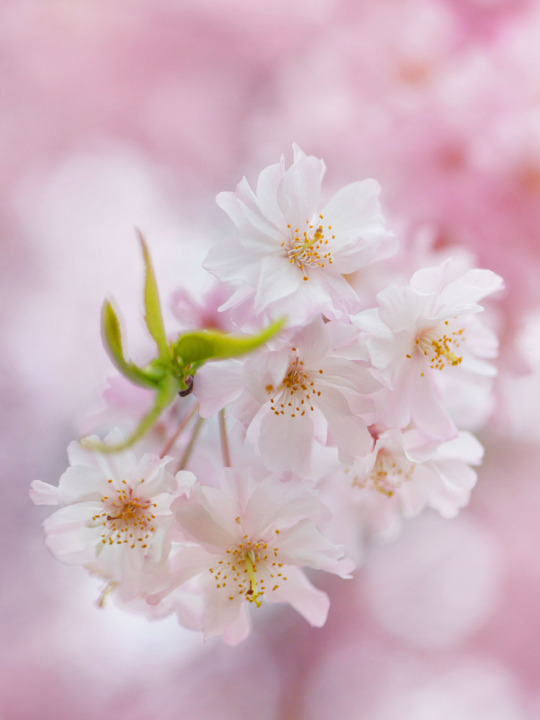

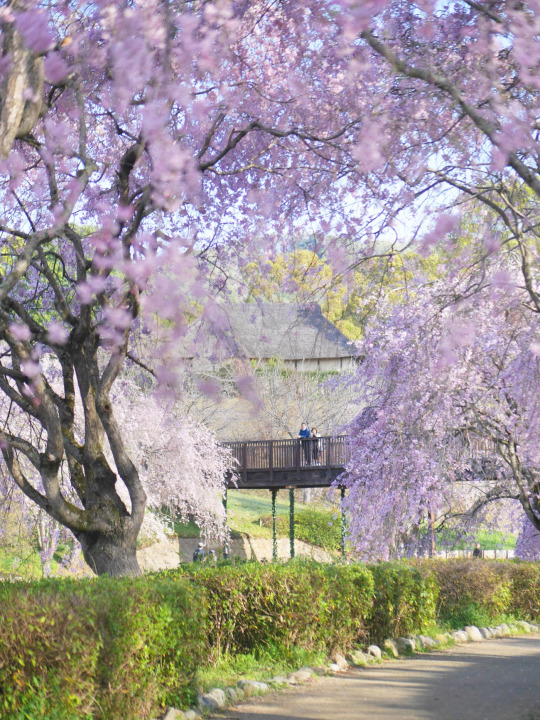
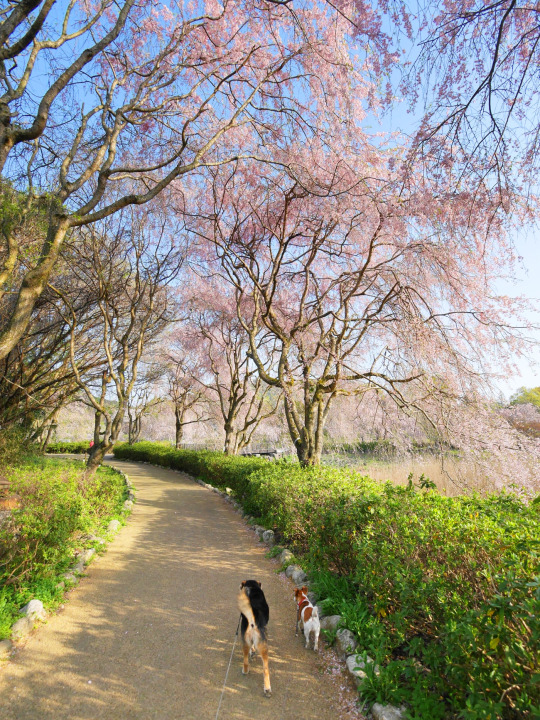





里の櫻 -Cherry blossoms in the village-
Hug had been feeling unwell since mid-March, and her poor condition lasted for about 4 weeks. However, this year, the full-fledged cherry blossoms bloomed quite late, so I was able to enjoy cherry blossom viewing with Hug, who has recovered.
Everything is not just a matter of course. I am deeply grateful for our beautiful and lovable everyday life :-))
3月中旬から4週間ほど、ハグが体調を崩した状態が続いていました。シニア齢になってからなにかしらの病気に罹ると治りが遅くなる傾向にはあったものの、ここまで長引くのは初めてのことで、イヌ飼い達の間では、しばしば愛犬の健康について「13歳の壁」なんていう話題が出るんですけど、ハグもいままさにその年齢であり色々と考えさせられてしまいます。
でも無事に回復してくれ、今年は桜の開花がかなり遅かったおかげで、元気を取り戻したハグと例年通りにお花見散歩ができたことがしみじみとうれしく感じられたのでした🌸😚🐶🌸
https://m.youtube.com/watch?v=DhMnhIY1pE0
297 notes
·
View notes
Text
Authentic Japan in Gyakuten Saiban pt. 1
Those who played the Ace Attorney localization know that all the names authentic to Japan were either changed to common ones, or more or less explained by the characters watched movies/TV series and so on.
And what about the original Japanese version?
We encounter the decoration of a Japanese house in 2-2, when we visit the Kurain village. And what is noteworthy is that Naruhodō is well informed about such items and actively comments on each of them.
For starters, the curious name of one of the locations

同日 某時刻
綾里家・わたりろうか
Dōjitsu bō jikoku
Ayasato-ka watari rō ka
Same day, at a certain time
Ayasato family, Watarirōka
渡り廊下 (watarirōka) - passage
The word consists of the following kanji:
渡り (watari) - transit, ferry, cross
廊 (rō) - corridor, hall
下 (ka) - below, down, descend, low, inferior
I have an idea why the localization called this location "Winding Way", but I'm not a native speaker, so I can't be sure of the correctness of my conclusions. "Wind your way" fits the meaning quite well, but in my opinion, there was no point in reinventing the wheel and calling the "corridor" something else.
___________________________________________
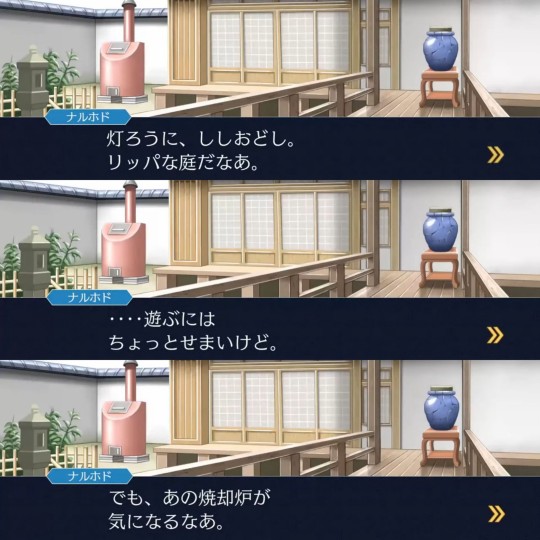
灯ろうに、ししおどし。リッパな庭だなあ。
tōrō ni, shishi odoshi. Rippana niwada nā.
Tōrō lanterns and Shishiodoshi. What a nice garden.
・・・・遊ぶには ちょっとせまいけど。
asobu ni wa chotto semaikedo.
... It's a little small to play in though.
でも、あの焼却炉が気になるなあ。
demo, ano shōkyakuro ga ki ni naru nā.
But I'm curious about that incinerator.

鹿威し (ししおどし) [shishiodoshi] - water-filled bamboo tube which clacks against a stone when emptied, device for scaring birds from gardens
___________________________________________

床の間。・・・・ぼくにはどうも、 この空間のイミがわからない。
tokonoma. Boku ni wa dōmo, kono kūkan no imi ga wakaranai.
Tokonoma. ...I don't really understand the meaning of this space.

事務所にこんなものがあったら、 あっという間に物置だな。
jimusho ni kon'na mono ga attara, attoiumani monookida na.
If I had something like this in my office, it would just turn into a storage room.

しかしここには、きれいな花とシャレた掛け軸がかざってある。
shikashi koko ni wa, kireinahana to shareta kakejiku ga kazatte aru.
But there are beautiful flowers and stylish hanging scrolls here.
Tokonoma is an alcove or niche in the wall of a traditional Japanese home, one of the 4 main components of the main room of a Japanese aristocratic house.
Tokonoma should contain only art objects, such as kakemono - a scroll with a painting or a calligraphically written saying, motto or poem. Also, a small flower arrangement (ikebana) is a common attribute.
Interesting fact: according to Japanese etiquette, the most important guest sits with his back to the tokonoma.
Now pay attention to where and how the futon is located, on which the guest in the beret slept (if she had sat down on the futon, she would have ended up with her back to the tokonoma). Here you have a "simple student studying the occult".
Well, the fact that Naruhodo sees no point in having such a space in the house and is ready to use it as a warehouse, completely ignoring its original purpose, tells us that for him it is considered a relic of the past and has no sacred meaning (even as an art object). He is a modern resident of modern Japan, where there is no place for such traditions.
___________________________________________
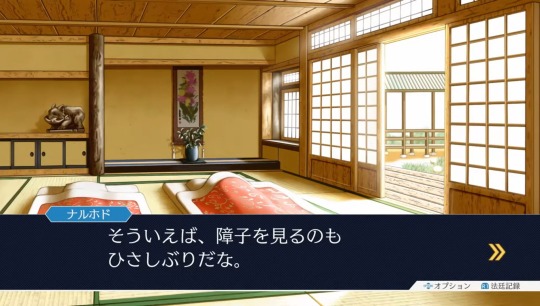
そういえば、障子を見るのもひさしぶりだな。
sō ieba, shōji o miru no mo hisashi-burida na.
Now that I think about it, it's been a while since I last saw a shoji screen.
___________________________________________

青あおとしたサカキが まつられている。
aoao to shita sakaki ga matsura rete iru.
A blue Sakaki tree is enshrined here.
Cleyera japonica (sakaki) is a flowering evergreen tree. It is considered sacred to Japanese Shintō faith, and is one of the classical offerings at Shintō shrines. In Shinto ritual offerings to the "gods; spirits" (神, kami), branches of sakaki are decorated with paper streamers (shide) to make tamagushi.

It turns out to be quite interesting - if a person is not familiar with these interior items, then not only will he not tell anything about them, but he will not even know what they are called. Naruhodo, whose childhood fell at the end of the 20th - beginning of the 21st century, could have learned about this only in a couple of cases:
1. He had been in a traditional Japanese house before, saw these items and was told about them by older relatives;
2. He independently studied old interior items (which is not surprising, because he studied art at the university).
This is also confirmed by his comment about shoji: "it's been a while since I last saw a shoji screen".
That is, he saw all this with his own eyes, but quite a long time ago.
Naruhodo is quite well educated in the culture of his own country, although some things have already lost their sacred meaning for him and are not used by him (and, possibly, his family) in everyday life.
Let's continue in the next part.
#ace attorney#gyakuten saiban#phoenix wright#naruhodo ryuichi#i said what i said#in the gks universe together with croq#long time no see
51 notes
·
View notes
Text
Scan and transcription of the Persona 3 part of Newtype Magazine February 2016
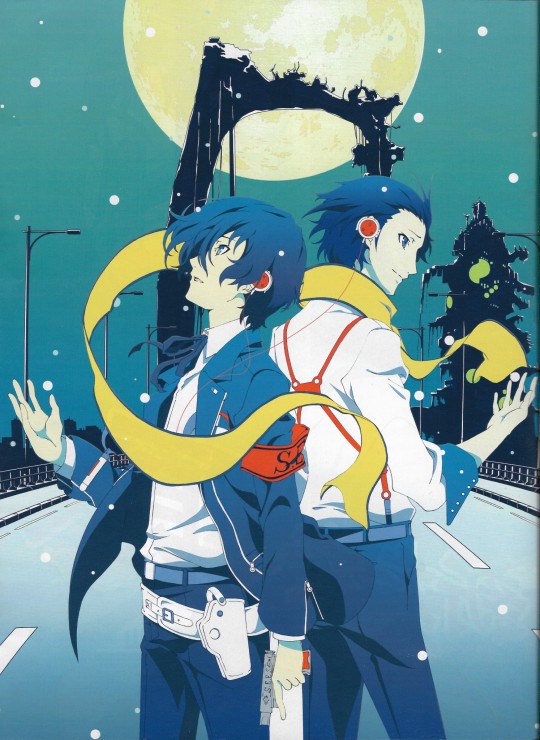

春、夏、秋を経て冬、理が出す答えを見届けて
監督 田口智久
死を見つめる季節のフィナーレに
第1章でコンテ、第2章で監督を務めてこられた劇場版「ペルソナ3」ですが、ファイナル・シーズンである第4章は、どのような気持ちで臨んだのでしょう?
田口 第3章で自分が監督としてかかわっていない劇場版「ペルソナ3」を見ることができたのが、刺激になりました。自分とはまったく違う方法論で構築されていて��僕がやったら確実にこうならないですし、なんというかジェラシーのようなものを感じまして。ああ、ペルソナって、こういうふうにつくることもできるんだ、と。それを受け止めることができたからこそ、第4章では、自分のやり方を突き詰めたフィルムにしなくてはと思いました。あとは、やっぱりフィナーレということでのプレッシャーが大きかったです。
第4章の物語の関となるのは?
田口 理と綾時の関係性ですね。そこヘシャドウの母体であるニュクスが襲来したり、それに伴ってみんなの心がダウナーになって⋯⋯という展開で、ずいぶん重いものになっています。でも、みんなが悩んでいる部分にしっかり尺を取って描いているので、映画ならではの見せ方ができているのでは、と思います。
理にスポットが当たっていきますが、どのように描きましたか?
田口 第3章に、理が旅館の池に落ちて笑うシーンがありますけど、あの理を経ての理をしっかり追っていこうと考えていました。今作では、抱えきれないほどの絶望を前に、悩み、立ち止まってしまうというところまで、みんなが落ちてしまうんですけど、そのなかで理が見つけ出す答えというのが、全4章通してのテーマでもあり、象徴的なセリフになっています。そして、それは、第3章で笑った理がいなければ、たどり着けなかった答えなんじゃないかな、と。
それから、綾時とアイギスも、重要な存在ですね。
田口 すごく極端な⋯⋯本当に超極端な言い方ですけど「綾時と理は両想い。アイギスは理に片想い」っていうのを、こっそり頭の片角に置いてました(笑)。もちろん僕独自の解釈なので、いろんなとらえ方をしてほしくもあるのですが。ただ、そうやって、アイギスがヒロイン然としているわけではないからこそ、ペルソナならではの仲間感が出る、というのもあるんですよね。
理と綾時に重点が置かれていくとなると、その二役を演じられている石田彰さんのアフレコもすさまじいものになったのでは。
田口 石田さんだけ別の週に理以外の綾時を中心とした声を録らせていただいてから、全体アフレコの週に理としてみんなといっしょに録らせていただいた感じなんですけれど、本当にすばらしかったです。演技に対するストイックさが本当にプロフェッショナルで、ご自身で「今のは少し綾時が出てしまったから」とリテイクを申し出てくださったり。
全体的にも、とてもスムーズなアフレコになったそうですね。
田口 圧倒的にスムーズでした。特に今回は静かなシーンが多くて、感情的にセリフを吐くような場面はほとんどないんですけど、その淡々とした空気感を成立させるのは難しいはずなのに、自然にスッとやってしまえるのがこのチームの方々の成せる技。こんなに研ぎ澄まされた現場は、なかなかないのではないかと。
細かな心情描写という意味では?画づくりにもこだわられたのでは?田口監督の描き出すダウナーな情景描写が楽しみです。
田口 カッティングが終わった後に、編集さんに言われたひと言が「暗っ!」でしたからね(笑)。刺されて死ぬとか大惨事が起こって死ぬとかのサスペンス的な死ではなくて、非常に観念的な死についての物語なので、精神的にどうやられていくかというのを、どう表現するかが課題で。光や色味の演出であったり、降ってくる雪の量で表現していきました。アニメで雪が降りつづけている作品もあまりないんじゃないかと思うんですけど、心情とマッチさせたいなあというところで、力を入れています。作画もすごいアニメーターさんたちが集まってくださっていて、誇張された動きというよりはリアル寄りの芝居をていねいに描いてくださっています。全然動いているように見えないところにも実は枚数が割かれていて、作画枚数もこれまででいちばん使っているんですよ。
最後に、今作を描くうえでの最大のポイントだったと考えるシーンを教えてください。
田口 ラストですね。それは第4章を担当すると決まったときから、見据えていたビジョンでもあります。第1章の春からともに季節を経てきた理と仲間たちが迎える、そのラストを見届けてほしいです。
#1 Spring of Birth
1日と1日のはざまに隠された影時間。そこにはびこる怪物・シャドウに襲われて、無気力症となってしまう者が町に続出していた。対抗できるのは、ペルソナという特殊な能力をもつ者だけ。春、私立月光館学園に転校してきた結城理は、ペルソナの力に覚醒し、同じくぺルソナの力をもつ者たちが集う特別課外活動部へと引き入れられる
#2 Midsummer Knight's Dream
夏休みに屋久島旅行に向かった特別課外活動部。そこでアイギスという女の子に出会う。彼女は対シャドウ特別制圧兵装のラストナンバーであり、なぜか理のそばにいることを望むのだった。理たちは影時間の謎を追いながら、さらに新たな仲間と出会い、きずなを深めていく。だがそこにストレガと名のる者たちが現われ⋯⋯
#3 Falling Down
季節は秋。特別課外活動部は、影時間を終わらせるため、シャドウや滅びを望むストレガとの死闘を重ねていた。ある者は仲間や家族の死と向き合い、ある者は護るべき者に気づき、ある者はこれまでの戦いの意味に葛藤する。そんなとき、理の前に謎の転校生、望月綾時が現われる。その出会いの先にあるものは⋯⋯
「PERSONA3 THE MOVIE #4 Winter of Rebirth」
●1月23日土全国ロードショー
●第3章Blu-ray&DVD 1月20日水発売
WEB▶http://www.p3m.jp/
Twitter▶@P3movie
illustrated by YUKIO HASEGAWA, finished by SAORI GODA
background by BIHOU, text by HITOMI WADA
©ATLUS ©SEGA/劇場版「ペルソナ3」製作委員会
STAFF 原作=「ペルソナ3」(アトラス) 脚本=熊谷純 スーパーバイザー=岸誠二 キャラクターデザイン=渡部圭祐 ペルソナデザイン=秋恭摩 プロップデザイン=常木志伸 色彩設計=合田沙織 美術監督=谷岡善王(美峰) 美術設定=青木薫(美峰) コンポジット&ビジュアルディレクター=高津純平 編集=櫻井崇 音楽=目黒将司、小林哲也 音響監督=飯田里樹 第4章監督=田口智久 制作=A-1 Pictures
CAST 結城理=石田彰 岳羽ゆかり=豊口めぐみ 伊織順平=鳥海浩輔 桐条美鶴=田中理恵 真田明彦=緑川光 山岸風花=能登麻美子 アイギス=坂本真綾 天田乾=緒方恵美 荒垣真次郎=中井和哉 イゴ ール=田の中勇(特別出演) エリザベス=沢城みゆき
#persona 3#p3#ryomina#that tag's deserved i think#'Ryoji and Makoto are in love with each other. Aigis' feelings for Makoto are unrequited'#insane
99 notes
·
View notes
Text
夏のアツさを吹き飛ばす!Gフェス開催!完成披露試写会イベントレポート
この度、7月25日(火)に『Gメン』完成披露試写会を実施!岸優太、竜星涼、恒松祐里、矢本悠馬、森本慎太郎、りんたろー。、吉岡里帆、高良健吾、尾上松也、田中圭、瑠東東一郎監督の総勢11名が登壇しました!
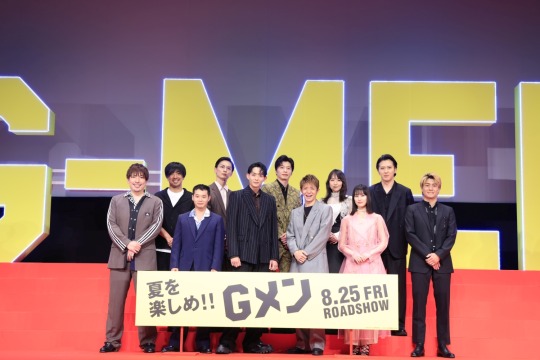
イベントが始まると、会場では色とりどりのレーザーが飛び交い、キャストの紹介映像が上映。ザ・クロマニヨンズによる主題歌「ランラン」が鳴り響くと幕が上がり、高さ2.5mもある「G-MEN」巨大モニュメントをバックに、キャストと監督が登場しました。壇上に据えられた大階段から降りて舞台へやってくると、ド派手な演出で登場した総勢11名を前に、観客の熱気と歓声は最高潮!場内は一気にお祭りムードに!
最初に登壇者全員から自身の役紹介とともに挨拶があり、その後本編に関する質疑応答へ。1年G組の5名の仲の良さや、高良・田中・松也から見たG組メンバーの様子、癖のあるキャラクターを演じた吉岡の心境、岸から見た先輩達への印象、瑠東監督よる作品への想いや、本作の撮影秘話などが語られました。また、みんなからの無茶振りに、岸が渾身のGメンギャグを全力で披露する場面も!
続いて、フリップへ記述し質問に答えるコーナーでは<自分が演じた役以外で演じてみたいのはどのキャラ?><友情・ケンカ・恋愛と青春がギュッとつまった『Gメン』ですがズバリみなさんの青春を一言で表すと!>というお題に対して出演者がコメントしました。
さらに、岸の呼びかけで、登壇者と会場が一体となり「この夏は、Gメン!」と掛け声をし、キャノン砲が発射!会場は大熱狂の中、イベントの幕が閉じました。
詳しいトークの内容は、8月10日(木)に配信される「Gフェス後夜祭」ダイジェスト映像をチェック!
506 notes
·
View notes
Text


【ゆるキャラ】きの山さん&たけっち(明治)
しばしば議論になる、明治のお菓子「きのこの山」と「たけのこの里」のキャラクター。
着ぐるみになるとかなり大きくなる。
"Kinoyama-san" and "Taketchi", Meiji Co. Ltd, Japan.
#mascot#マスコット#yuruchara#ゆるキャラ#kigurumi#着ぐるみ#japan#costume#chocolate#チョコレート#明治#きの山さん#たけっち#きのこの山#たけのこの里
69 notes
·
View notes
Text
D.Gray-man c249 p19-27
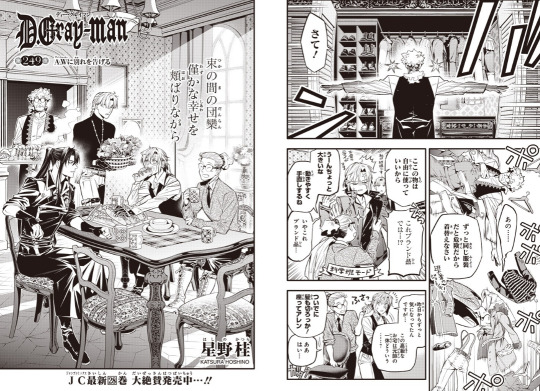
SPOILERS FOLLOW + some translations of what I could gather. Parts, I’m unsure about.

再び無事に会おう Let’s (all) meet again safely.

神田ぁッ Kanda!!
!?
オレをアレンのもとまで届けてくれてありがとうー Thank you for sending me to Allen’s side--!!
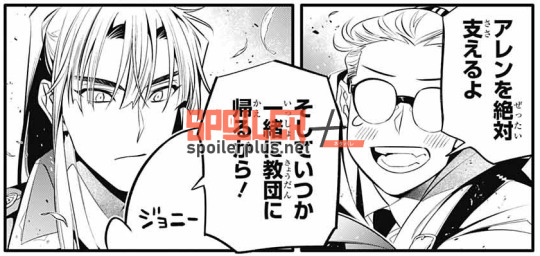
アレンを絶対支えるよ そしていつか一緒に教団に帰るから! I’ll definitely support Allen, and then eventually we’ll return to the Order together! (lit. “one day”)
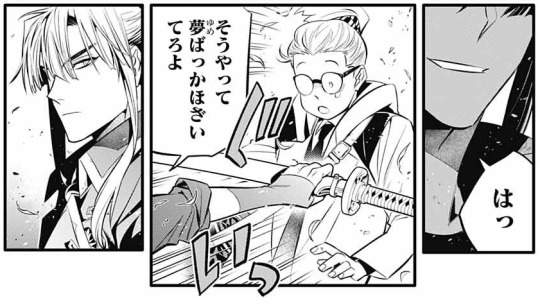
はっ そうやって夢ばっかほざいてろよ Ha. Just keep prattling on about your dreams like that.

...おまえら科学班にはそれが似合ってる ...it suits you Science Department guys.
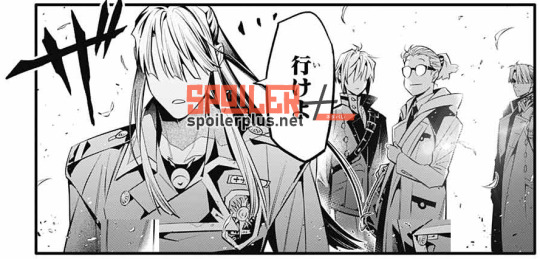
行けよ Let’s go.
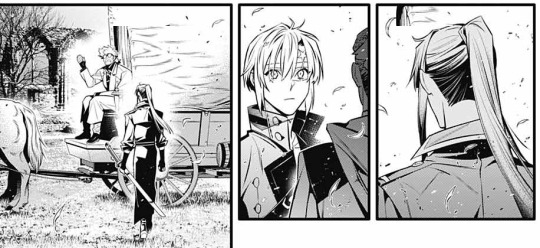

出発しましょうウォーカー Let us depart, Walker.
あ うん... Ah, yeah...

これで本当いいんだね?クロス Is this really okay? Cross.
本当にこれで...Really, just like this...
あの子は行ってしまったよ That child is really gone.
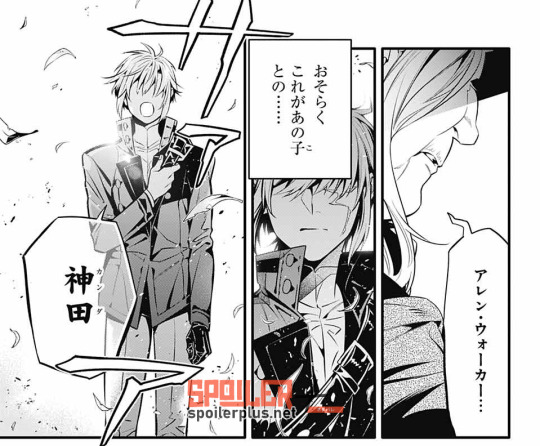
アレン・ウォーカー... Allen Walker...
おそらくこれがあの子との...That child is probably already...
神田 Kanda.
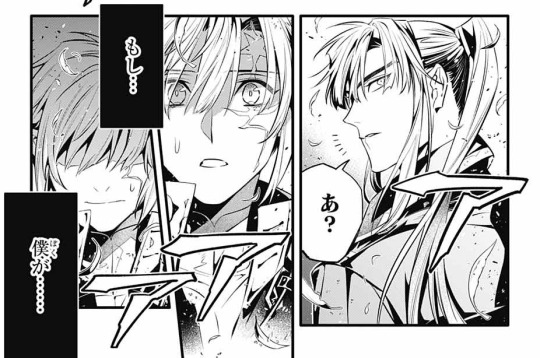
あ? Hm? (lit. Ah?)
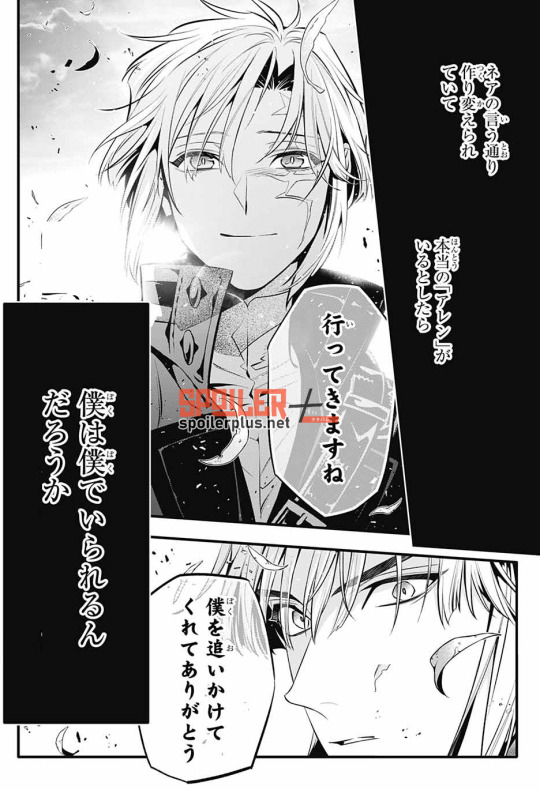
行ってきますね I’m off. (I’ll go and come back.) 僕を追いかけてくれてありがとう Thank you for chasing after me. (くれて means “for me”, so ‘thank you for coming after me for my sake’)
もし... 僕が... ネアの言う通り作り変えられていて 本当の「アレン」がいるとしたら 僕は僕でいられるんだろうか If... I’ve been remade as Nea says, and there exists the real “Allen”, I wonder if I can remain as myself. (lit. Can I remain/exist as me? --I think.)

神よ Oh, God もしおわすならば どうかこの老婆にもクロス・マリアンと同じ罰をお与えください If you’re there, then please grant this old woman the same punishment as Cross Marian.

あの子はもう帰ってはこまい...... That child can no longer return...... ...さようなら...... Goodbye...
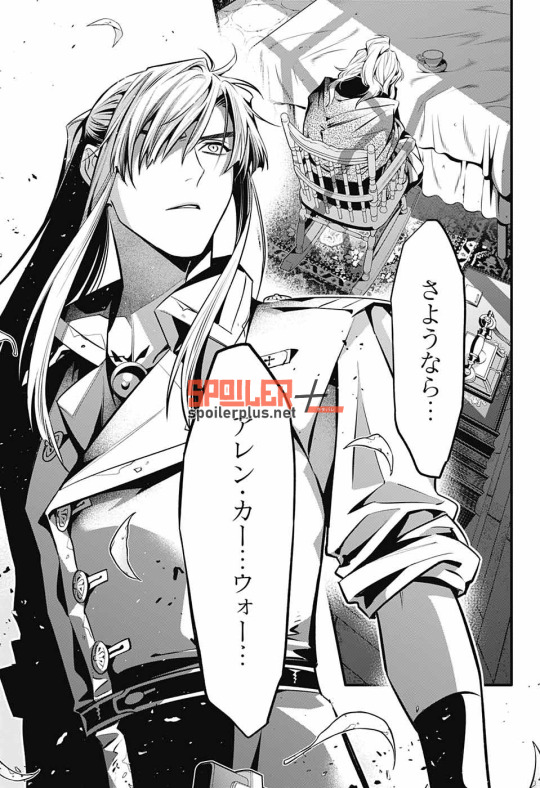
さようなら...アレン・カー...ウォー... Farewell... Allen Walker...

自身への疑念を抱きながら アレン・ウォーカーは一路ズーグル古書店へ向かう待ち受ける真実ははたして何を代償とし誰を救うのか While carrying self-doubt, Allen Walker heads directly to Zoogle Antiquarian Bookstore. What will be the cost of the truth that awaits him, and who will be saved?
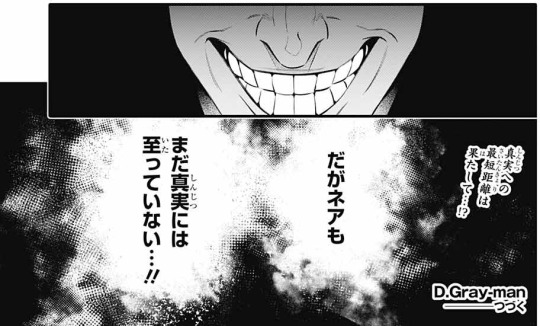
真実への最短距離(郷里)は果た一て...!? The shortest path (furigana: Nea’s birthplace) to the truth is...?!
だがネアも まだ真実には至っていない...!! However, Nea also has yet to reach the truth...!!
206 notes
·
View notes
Photo

(Xユーザーの朱里/shuriさん: 「ちょいちょいお声を頂いていたので変なものを借りてきてしまった姫様のえっちなあれこれをアップしました。 大きいお友達のみ閲覧が可能です。よろしければ🙏 https://t.co/bmyXTfIsKY https://t.co/xt6gYbeYLK」 / Xから)
57 notes
·
View notes
Text
列車寸景 ~ 初冬の唐津線・筑肥西線 2024

↑西唐津の車両センター ↓鬼塚駅のキハ125形気動車

↓山本駅 … 唐津線と筑肥線の分岐駅

かつての筑肥線は虹ノ松原から別ルート(廃線)で山本駅につながっていて、唐津線との接続駅でした。また、唐津線の支線(岸嶽支線・廃線)の起点駅でもあったそうです。

↑佐賀(唐津線)、伊万里(筑肥線)方面 ↓唐津方面

駅舎 … 1912年(大正元年)建築の歴史がある。昔の出札口(きっぷ売り場)は板で塞がれてい哀れな感じ。

保線車両 … 0番のりばの跡(北波多方面に向かう唐津線の岸嶽支線が発着していた。)









YouTube > 列車寸景~初冬の山本駅(14分)

再び西唐津車両センター(遠景)

303系電車


キハ(気動車・ディーゼルカー)


2024.11.20
23 notes
·
View notes
Text
何年か前私はここでインスタントオナニーの話をした。名前の通り手っ取り早い自慰行為なんだけど、今はその逆でタイパより丁寧さに最近力を入れている。手っ取り早くしすぎたせいで、慣れもあったし、なんせ、行為自体早く終わらせなきゃ悪、みたいな思いが勝手に付いてきていた。セックスレスにも繋がるけど、慣れと手っ取り早さを行為に当て嵌めてはいけない。
最近読み始めた本がある。アンソロジー本で『私の身体を生きる』各著者の性や身体に関することがエッセイとして書かれている。私の知らない部分を見入っては圧巻というか関心というか。20代後半になって性に関することで悩んだり通院することになったり三大欲求であると共に切るに切り離せないものだと思っているので、これを機に振り返ってみようと思う。
私の初体験は知らない男だった。知らないというのは素性をそこまで知らずインターネットで知り合った男だった。私は16、向こうは32。家の縛りや慣習に辟易として早く捨ててしまいたいと思っていた。初めて行ったラブホテルは部屋になぜか自転車が置いてあったので今でも印象に残っている。わからないなりに咥えたり喘いでみたりしたけど挿入時は痛みがあった。出血はしなかったことに安心した。その後、大学進学のための上京で欲が爆発した。行為が好きだった、裏にはいつと贖罪があった。好きにさせてしまった、と思えば身体を差し出して許しを乞うてみたり、可哀想だから、と頭ひとつ出て相手を見下している部分もあった。そんな私を知った母親から「私は純潔で父に捧げた」と言われた時は取り戻せない後悔より、だから?と見下していた。
コロナ禍に学生に戻った時なんてTinder無双をした。チンソムなんてしょうもない事もしていた。
欲だから浮き沈みもあって、修論書いていた時は1年間性行為と無縁だった。っていいように書いてみたものの、無双の中で出会った男に無理矢理犯されて痛みと共に下物の色がおかしくなってその時初めて婦人科に行った。M字開脚に放心になりながらも、異形成と知りコルポスコピーも受けた。癌になるかならないかのグレーゾーン判定を受けた時は人生呆気ないかも、と思った。結局なんやかんやで生き延びているし、最近の定期検診も��丈夫だったので適度に生き抜いていきたい。
再社会人になってからも少し遊んでいたが、ピルを飲み始めたら体調が悪くなった。常に気持ちが悪く、欲もどうでもよくなった。丁度その頃付き合い始めた恋人と燃えあがるような想いと行為だったのに、ピルと具合の悪さが続いて花火のように消化してしまった。ちょっとした興味本位もあったのに、なんだかなぁ。
夜になると欲を消化しないと眠れない日々が続いた。冒頭のようにしていたら、上手く達せられなくて、脚ピンの良くない体位でどうにか、を繰り返した。パブロフの犬。
夫婦間のレスの投稿をXかnoteかはてなで読んだ。行為が嬉しさだと気付いたような文を読んだ時は、幸せの先の嬉しさか、嬉しさゆえの幸せか鶏卵になった。
飲み会や日常で聞く下ネタに嫌悪を抱いている。どうでもええわ。が核心。勝手に私の知らないところで勝手にどうにかしてください。奥ゆかしさこそみたいなものもある気がする。(知らんがな)
29にして常日頃将来を見つめ直し思い悩んでいる。性もそう。このままじゃと思って伝えたけど、家族になり過ぎる前に妊娠出産を得ないと安寧に縋ってしまうかもしれないと自分自身で思う。この脅迫概念に近しいものは、時期やイベントが過ぎれば呆気なかったなと思うかもしれない。わからないが故に時間と共に杞憂して焦っている。女故の性に囚われてしまっている。
消費期限と揶揄されることがあり、焦るにせよみないにせよ人生80年、100年ある中でなんたる微々たるものよ。
私の性は自分のものでいたいけど、世間的にといい家族といいレールに敷かれる上でぞんざいに扱われている気がする。
22 notes
·
View notes
Text



2024.11.30(土)
今年も年末近しということで、先週家の床のワックスがけ、本日は雨の合間合間ををぬって自動車2台分の冬用タイヤへ交換をした。
これでいつ雪が降っても安心できる。
午後は国民宿舎 鷹巣荘の源泉かけ流しの湯で疲れを癒す。
ところで、最近雨が多くてお出かけするのも躊躇う。北陸らしい天気といえば天気なのだが。
ねむれとか 又さませとか 初しぐれ 哥川
こういう日は俳句のように家でのんびり昼寝をしたり、また本を読んだり、外出するにしてもcafeでぼんやりと過ごしたいとも思うようになった。
本といえば、白洲正子著の紀行文「かくれ里」を読んだ。近江、京都など気になった場所を訪れてみたい。
写真は台湾土産の「COOKIE886」。他にメンマとカラスミも頂いた。
「カラスミ」って初めて食したけれど、味はウニとよく似ていておいしかった。日本酒とも合う。値段は結構お高いようなので、自分では買わない(買えない)。
それといつか行ったcafeの写真。
38 notes
·
View notes